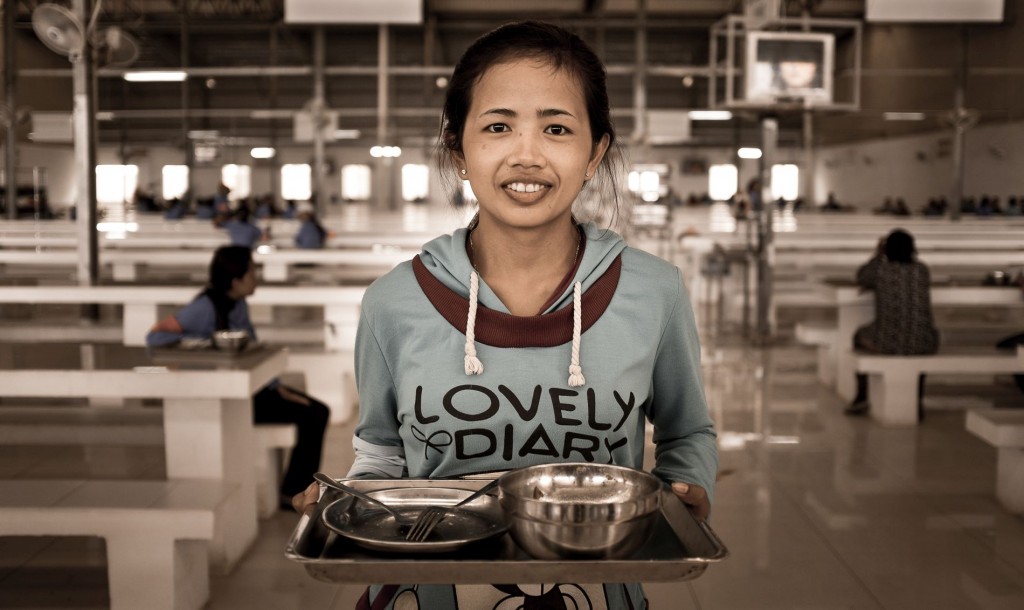
កម្មការនីកាត់ដេរកំពុងទទួលអាហារពីរោងចក្ររបស់នាង នៅប្រទេសកម្ពុជា។ រូបភាព ថតដោយ អង្គការពលកម្មអន្តរជាតិ (អាស៊ី-ប៉ាស៊ីហ្វិច) និង ត្រូវបានដាក់បង្ហោះ កាលពីថ្ងៃទី១៤ ខែកក្កដា ឆ្នាំ២០១៥។ ក្រោមអាជ្ញាប័ណ្ណ CC BY 3.0 IGO។
ក្នុងអំឡុងឆ្នាំ ២០១៤-២០១៦ ការនាំចេញសម្លៀកបំពាក់ និងស្បែកជើងនៅកម្ពុជាបានកើនឡើងក្នុងជំហានមួយដ៏រឹងមាំក្នុងប៉ុន្មានឆ្នាំថ្មីៗនេះ ជាមួយនឹងអត្រាកំណើនប្រចាំឆ្នាំ ១០,៨ ភាគរយក្នុងមួយឆ្នាំ។1
វាបានរីកចម្រើនយ៉ាងឆាប់រហ័សក្លាយជារោងចក្រថាមពលសម្រាប់សេដ្ឋកិច្ចកម្ពុជាដែលផលិតការនាំចេញចំនួន ៧,៩៧ ពាន់លានដុល្លារក្នុងឆ្នាំ ២០១៩។ 2
ប្រទេសកម្ពុជាគឺជាប្រទេសមួយក្នុងចំណោមប្រទេសនាំចេញសម្លៀកបំពាក់ធំជាងគេទាំង ១០ នៅលើពិភពលោកនាពេលបច្ចុប្បន្ននេះ។3
ដោយមានជំនួយពីសិទ្ធិពាណិជ្ជកម្មដែលផ្តល់ដោយសហរដ្ឋអាមេរិក និងសហភាពអឺរ៉ុប ឧស្សាហកម្មនេះបានរីកដុះដាល។ វាបានចូលរួមចំណែកចំនួន ៧៤ ភាគរយនៃការនាំចេញសរុបរបស់កម្ពុជានៅក្នុងឆ្នាំ ២០១៨4 នៅឆ្នាំ ២០១៨ វាបានរួមចំណែកជិត ១១.៣ ភាគរយនៃកំណើនផលិតផលក្នុងស្រុកសរុប ៧ ភាគរយ របស់ប្រទេស។5
នៅក្នុងឆ្នាំ ២០១៩ របាយការណ៍ពីអគ្គនាយកដ្ឋានគយ និងរដ្ឋាករនៃក្រសួងសេដ្ឋកិច្ច និងហិរញ្ញវត្ថុបាន ឱ្យដឹង ថាប្រទេសកម្ពុជាបាននាំចេញនូវផលិតផលសម្លៀកបំពាក់វាយនភណ្ឌ និងស្បែកជើងដែលមានតម្លៃជាង ៧,៩៧ ពាន់លានដុល្លារក្នុងរយៈពេល ៩ ខែដំបូងនៃឆ្នាំនេះ ជាចំនួនកើនឡើង១៣,១៨ ភាគរយពីមួយឆ្នាំទៅមួយឆ្នាំ ដែលកើនពី ៧,០៤៤ ពាន់លានដុល្លារ។ ការនាំចេញទៅសហរដ្ឋអាមេរិកមានទំហំប្រហែល ២,៥ ពាន់លានដុល្លារ ខណៈការនាំចេញទៅសហភាពអឺរ៉ុបមានចំនួន ២,៤ ពាន់លានដុល្លារ ដោយការនាំចេញទៅអង់គ្លេស ៦៧០ លានដុល្លារ ជប៉ុនចំនួន ៧១១លានដុល្លារ រដ្ឋសមាជិកអាស៊ាន ១២១ លានដុល្លារនិងប្រទេសដទៃទៀត ១,៥ ពាន់លានដុល្លារ។6
គំរូផលិតកម្ម
រោងចក្រនាំចេញរបស់កម្ពុជាភាគច្រើនធ្វើប្រតិបត្តិការទៅនឹងគំរូ cut-make-pack (CMP) ។ ពួកគេផលិតសម្លៀកបំពាក់ដែលមានតម្លៃបន្ថែមទាប ជាមួយនឹងការរចនាម៉ូដ និងការសម្រេចចិត្តលើការផលិតធ្វើឡើងនៅក្នុងប្រទេសផ្សេងទៀត។ ក្នុងករណីភាគច្រើន វត្ថុធាតុដើមត្រូវបាននាំចូលមកពីចិនដីគោក ហុងកុង តៃវ៉ាន់ ជប៉ុន វៀតណាម និងកូរ៉េ។7
ការងារនិងប្រាក់ឈ្នួល
វិស័យកាត់ដេរសម្លៀកបំពាក់និងស្បែកជើងនៅតែជានិយោជិកដ៏សំខាន់សម្រាប់កម្លាំងពលកម្មនៅកម្ពុជា។ នៅក្នុងឆមាសទីមួយនៃឆ្នាំ ២០១៧ វិស័យនេះបានផ្តល់ការងារជាមធ្យមចំនួន ៦៣៥,០០០ ក្នុងមួយខែនៅក្នុងរោងចក្រនាំចេញដែលបានចុះបញ្ជីហើយបន្ថែមការកើនឡើងប្រមាណ ៤ ភាគរយបើធៀបនឹងរយៈពេលដូចគ្នាកាលពីឆ្នាំមុន។ តួលេខថ្មីៗបន្ថែមទៀតគឺជាការប៉ាន់ស្មានប៉ុន្តែប្រភពឧស្សាហកម្មបានដកស្រង់តួលេខកម្មករដែលមានចំនួនច្រើនដល់ទៅ ៧៥៤.០០០ នាក់។8
រោងចក្រកាត់ដេរនៅកម្ពុជាភាគច្រើនមានម្ចាស់នៅឯនាយសមុទ្រ។ សមាជិកសមាគមរោងចក្រកាត់ដេរកម្ពុជាមកពីប្រទេសចិនដីគោក (៣៣ ភាគរយ) តៃវ៉ាន់ ២០ ភាគរយហុងកុង ១២ ភាគរយកូរ៉េ ១១ ភាគរយជប៉ុន (៥ ភាគរយ) និងរដ្ឋដទៃទៀតរួមទាំងកម្ពុជា (១៩ ភាគរយ) ។9
វិក័យប័ត្រប្រាក់ឈ្នួលសរុបរបស់វិស័យនេះឈានដល់មធ្យម ១២៦ លានដុល្លារអាមេរិកក្នុងមួយខែក្នុងរយៈពេលពាក់កណ្តាលឆ្នាំដំបូងនៃឆ្នាំ ២០១៧ បើប្រៀបធៀបទៅនឹងប្រាក់ខែជាមធ្យម ១១៦ លានដុល្លារក្នុងរយៈពេលដូចគ្នាក្នុងឆ្នាំ ២០១៦។10 ប្រាក់ឈ្នួលសម្រាប់កម្មករកាត់ដេរមានរាងសំប៉ែតនៅដើមទសវត្សឆ្នាំ ២០០០ ហើយក្នុងរយៈពេលមួយទសវត្សរ៍ដំបូងពិតជាធ្លាក់ចុះ។ ទោះយ៉ាងណាចាប់តាំងពីឆ្នាំ ២០១០ ប្រាក់ឈ្នួលបានកើនឡើងទាំងលក្ខខណ្ឌបន្ទាប់បន្សំនិងតាមពិត។11 ប្រាក់ឈ្នួលអប្បបរមាសម្រាប់ឧស្សាហកម្មកាត់ដេរនិងវាយនភ័ណ្ឌដែលត្រូវបានកំណត់ជារៀងរាល់ឆ្នាំគឺ ៨០ ដុល្លារក្នុងមួយខែក្នុងឆ្នាំ ២០១៣ ។ តួលេខសម្រាប់ឆ្នាំ ២០១៨ ត្រូវបានកំណត់ត្រឹម ១៨២ ដុល្លារ។12
បេឡាជាតិរបបសន្តិសុខសង្គមរបស់ប្រទេសកម្ពុជាចុះបញ្ជីរោងចក្រកាត់ដេរ និងស្បែកជើងទាំងអស់ដោយមានបុគ្គលិកចំនួនប្រាំបីនាក់ ឬច្រើនជាងនេះ រាប់បញ្ចូលទាំងអ្នកម៉ៅការបន្ត និងមិនថាតើពួកគេនាំចេញ ឬអត់នោះទេ។ សម្រាប់ឆ្នាំ ២០១៦ មានរោងចក្រចំនួន ៨០០ បានចុះបញ្ជី។13 ផ្ទុយទៅវិញ ក្រសួងពាណិជ្ជកម្ម សមាគមរោងចក្រកាត់ដេរនៅកម្ពុជា និងគម្រោងរោងចក្រកាន់តែប្រសើរនៅកម្ពុជាបានកត់ត្រាថា មានរោងចក្រចំនួនតិចជាង ៦០០ បានចុះបញ្ជី។14 ភាពខុសគ្នានេះទំនងជាកើតឡើងដោយសារតែក្រុមហ៊ុនមិននាំចេញ និងក្រុមហ៊ុនម៉ៅការបន្ត។
បទដ្ឋានការងារនិងការត្រួតពិនិត្យ
ចាប់តាំងពីឆ្នាំ ២០០១ កម្មវិធីរោងចក្រកាន់តែប្រសើរនៅកម្ពុជា (BFC) របស់អង្គការពលកម្មអន្តរជាតិ បានអនុវត្តការត្រួតពិនិត្យ ការបណ្តុះបណ្តាល និងការរាយការណ៍អំពីលក្ខខណ្ឌការងារនៅក្នុងរោងចក្រនៅកម្ពុជា។15 កម្មវិធីនេះជួយអ្នកផលិតឱ្យយល់ និងគោរពតាមបទដ្ឋានការងារជាតិ និងអន្តរជាតិ និងជួយកម្មករឱ្យយល់ដឹងពីសិទ្ធិរបស់ពួកគេ។ រោងចក្រកាត់ដេរមួយត្រូវតែយល់ស្របនឹងការត្រួតពិនិត្យរបស់ BFC មុនពេលរដ្ឋាភិបាលផ្តល់អាជ្ញាប័ណ្ណនាំចេញ។
នៅខែវិច្ឆិកា ឆ្នាំ ២០១៦ កម្មវិធីរោងចក្រកាន់តែប្រសើរនៅកម្ពុជាត្រូវបានពន្យារពេលរហូតដល់ខែធ្នូ ឆ្នាំ ២០១៩ ដោយមានការគាំទ្រពីរដ្ឋាភិបាល (តាមរយៈក្រសួងពាណិជ្ជកម្ម និងក្រសួងការងារ) និងសមាគមរោងចក្រកាត់ដេរ។ នៅឆ្នាំ ២០១៧ ការវិភាគស្ថិតិបង្ហាញពីចំនួនក្រុមហ៊ុនម៉ៅការបន្តកើនឡើង16 ដែលផ្តល់ការងារ និងរួមចំណែកដល់កំណើន ប៉ុន្តែវាអាចត្រូវបានប្រើប្រាស់ជាវិធីមួយដើម្បីធ្វើអោយអន្តរាយដល់បទបញ្ជា និងប្រាក់ឈ្នួលអប្បបរមាដោយសារតែអ្នកម៉ៅការបន្តមិនត្រូវបានត្រួតពិនិត្យដោយ BFC និងទទួលបានការត្រួតពិនិត្យពីស្ថាប័នរដ្ឋាភិបាលតិចតួច។
របាយការណ៍នៃការដួលសន្លប់ ឬដួលលរលំជារឿងធម្មតា។ អ្នកសារព័ត៌មានមកពីកាសែតអង់គ្លេសឈ្មោះថា The Observer រួមជាមួយអ្នកតំណាងមកពីប្រព័ន្ធផ្សព្វផ្សាយដាណឺម៉ាក Danwatch បានសម្ភាសន៍កម្មករ សហជីព គ្រូពេទ្យ សប្បុរសជន និងមន្ត្រីរដ្ឋាភិបាលនៅកម្ពុជា។ ឧទាហរណ៍៖ ពួកគេបានរកឃើញថា “ស្ត្រីដែលដួលសន្លប់ធ្វើការរយៈពេល ១០ ម៉ោង ប្រាំមួយថ្ងៃក្នុងមួយសប្ដាហ៍ ហើយបានរាយការណ៍ថាពួកគេអស់កម្លាំង និងស្រេកឃ្លាន។ កំដៅលើសក៏ជាបញ្ហានៅក្នុងរោងចក្រចំនួនបីជាមួយនឹងសីតុណ្ហភាព ៣៧ អង្សាសេ។ យោងតាមសហជីព កិច្ចសន្យារយៈពេលខ្លីក៏ជាប្រភពដ៏សំខាន់នៃភាពតានតឹង និងហត់នឿយ។17
លោក ជាវ ប៊ុនរិទ្ធ ប្រធានការិយាល័យគោលនយោបាយ និងជាអ្នកនាំពាក្យបេឡាជាតិរបបសន្តិសុខសង្គមបានប្រាប់កាសែតថា ចំនួននៃការដួលសន្លប់បានថយចុះចាប់ពីចំនួន ១.៨០០ នាក់នៅឆ្នាំ ២០១៥ ដល់ ១.១៦០ ក្នុងឆ្នាំ ២០១៦ ដោយសារកម្មវិធីអប់រំស្តីពីអាហាររូបត្ថម្ភ និងការព្យាបាលដោយឥតគិតថ្លៃសម្រាប់អ្នកដែលមានអារម្មណ៍មិនស្រួលខ្លួន។
ម៉ាកយីហោសម្លៀកបំពាក់ធំៗ ជាទូទៅមានក្រមសីលធម៌ផ្ទាល់ខ្លួនដែលពួកគេតម្រូវឱ្យរោងចក្រប្រកាន់ខ្ជាប់។ ទាំងនេះអាចរាប់បញ្ចូលទាំងការកំណត់ម៉ោងការងារ សីតុណ្ហភាពអតិបរមា និងការហាមឃាត់ចំពោះកិច្ចសន្យារយៈពេលខ្លី។
ការប្រកួតប្រជែង បញ្ហាប្រឈម និងឱកាស
ឧស្សាហកម្មកាត់ដេរ និងស្បែកជើងកំពុងប្រឈមនឹងបញ្ហាជាច្រើនដូចជា៖
- បង្កើនការប្រកួតប្រជែងពីបណ្តាប្រទេសអាស៊ីផ្សេងទៀតជាពិសេស ប្រទេសមីយ៉ាន់ម៉ា និងបង់ក្លាដេស។18
- កិច្ចព្រមព្រៀងពាណិជ្ជកម្មសេរីរវាងសហភាពអឺរ៉ុប និងវៀតណាមដែលចាប់ផ្តើមនៅឆ្នាំ ២០១៨ និងបានធ្លាក់ជាបន្តបន្ទាប់នូវពន្ធនាំចូល ១២ ភាគរយរបស់វៀតណាមទៅដល់សូន្យ។19
- Brexit៖ ចក្រភពអង់គ្លេសបានទិញជិតមួយភាគបីនៃការនាំចេញសម្លៀកបំពាក់ និងស្បែកជើងរបស់កម្ពុជាទៅកាន់ទីផ្សារសហភាពអឺរ៉ុបទាំងមូលនៅឆ្នាំ ២០១៦។20
- បញ្ហាប្រឈមដ៏សំខាន់មួយទៀតនឹងកើតមាននៅពេលដែលប្រទេសនេះចៀសមិនរួចពីការរីកលូតលាស់ចេញពីប្រទេសដែលមានការអភិវឌ្ឍន៍តិចបំផុតរបស់អង្គការសហប្រជាជាតិ។ នៅពេលរឿងនេះកើតមានឡើងកម្ពុជាអាចបាត់បង់សិទ្ធិទទួលបានការអនុគ្រោះពន្ធសូន្យភាគរយ ដែលនៅពេលបច្ចុប្បន្ននេះមានទីផ្សារក្រៅប្រទេសមួយចំនួនដូចជា សហភាពអឺរ៉ុបជាដើម។
មានចលនាវិជ្ជមានផងដែរ៖
- នៅពាក់កណ្តាលឆ្នាំ ២០១៦ ប្រទេសកម្ពុជាមានសិទ្ធិទទួលបានការលើកលែងពន្ធទៅទីផ្សារទំនិញរបស់សហរដ្ឋអាមេរិកហើយផលិតកម្មសម្រាប់ទីផ្សារនោះកំពុងតែកើនឡើង។
- ប្រទេសកម្ពុជាកំពុងទទួលបានជោគជ័យក្នុងការបង្កើតទីផ្សារថ្មី។ ប្រទេសជប៉ុនបាននាំចូលសម្លៀកបំពាក់ និងស្បែកជើងត្រឹមតែ ២,៧ ភាគរយប៉ុណ្ណោះក្នុងឆ្នាំ ២០១០ ប៉ុន្តែ ៩ ភាគរយនៅឆ្នាំ ២០១៦។ប្រទេសកាណាដាបានទទួលត្រឹមតែ ០,៥ ភាគរយនៅក្នុងឆ្នាំ ២០១០ ប៉ុន្តែជិត ៨ ភាគរយនៅក្នុងឆ្នាំ ២០១៦។21
វាយនភ័ណ្ឌ
ខណៈពេលដែលវិស័យកាត់ដេរ និងស្បែកជើងបានរីកចម្រើនយ៉ាងខ្លាំងក្នុងរយៈពេល ២០ ឆ្នាំមកនេះ ឧស្សាហកម្មវាយនភ័ណ្ឌ ដែលគ្រាន់តែផលិតក្រណាត់នៅតែមានទំហំតូច។ ផលិតកម្មវាយនភ័ណ្ឌដែលមានទំហំពាណិជ្ជកម្មតម្រូវឱ្យមានការវិនិយោគច្រើនលើម៉ាស៊ីនធុនធ្ងន់ដែលត្រូវការថាមពលច្រើនដើម្បីដំណើរការ ប៉ុន្តែថាមពលដែលមានតម្លៃថ្លៃនៅក្នុងប្រទេសកម្ពុជា។ ម៉ាស៊ីនពីរនៅកម្ពុជាមួយនៅបាវិត និងមួយនៅកំពង់ឆ្នាំងផលិតក្រណាត់ត្បាញ។22
បានធ្វើបច្ចុប្បន្នភាព៖ ២០ វិច្ឆិកា ២០១៩
ឯកសារយោង
- 1. អង្គការពលកម្មអន្តរជាតិ (ILO). ព្រឹត្តិបត្រព័ត៌មានស្តីពីវិស័យកាត់ដេរ និងស្បែកជើងកម្ពុជាលេខ 6 ខែឧសភា ឆ្នាំ២០១៧។ ចូលអានថ្ងៃទី ២០ ខែវិច្ឆិកា ឆ្នាំ២០១៩។ https://ilo.org/wcmsp5/groups/public/—asia/—ro-bangkok/documents/publication/wcms_555290.pdf
- 2. ធូ វិរៈ ២០១៩. “ការនាំចេញវាយនភណ្ឌ សម្លៀកបំពាក់កើនដល់ជិត $៨ ពាន់លាន”, កាសែតភ្នំពេញប៉ុស្តិ៍, ចុះថ្ងៃទី១៩ ខែវិច្ឆិកា ឆ្នាំ២០១៩។ ចូលអានថ្ងៃទី ២០ ខែវិច្ឆិកា ឆ្នាំ២០១៩។ https://www.phnompenhpost.com/business/garment-textile-footwear-exports-nearly-8b-q1-q3
- 3. អង្គការពាណិជ្ជកម្មពិភពលោក ២០១៩. “ការត្រួតពិនិត្យទ្បើងវិញស្ថិតិពាណិជ្ជកម្មពិភពលោកឆ្នាំ ២០១៩”។ ចូលអានថ្ងៃទី ២០ ខែវិច្ឆិកា ឆ្នាំ២០១៩។ https://www.wto.org/english/res_e/statis_e/wts2019_e/wts2019_e.pdf
- 4. អង្គការពលកម្មអន្តរជាតិ (ILO) ខែឧសភា ឆ្នាំ២០១៩, ព្រឹត្តិបត្រព័ត៌មានស្តីពីវិស័យកាត់ដេរ និងស្បែកជើងកម្ពុជា: “វិស័យស្បែកជើង – ឱកាសថ្មីសម្រាប់កម្ពុជា?”, លេខ ៩ ខែកក្កដា ឆ្នាំ២០១៩។ ចូលអានថ្ងៃទី២០ ខែវិច្ឆិកា ឆ្នាំ២០១៩។ https://www.ilo.org/wcmsp5/groups/public/—asia/—ro-bangkok/documents/publication/wcms_714915.pdf
- 5. ដូចឯកសារយោង ILO ២០១៩។
- 6. ធូ វិរៈ ២០១៩. “ការនាំចេញវាយនភណ្ឌ សម្លៀកបំពាក់កើនដល់ជិត $៨ ពាន់លាន”, កាសែតភ្នំពេញប៉ុស្តិ៍, ចុះថ្ងៃទី១៩ ខែវិច្ឆិកា ឆ្នាំ២០១៩។ ចូលអានថ្ងៃទី ២០ ខែវិច្ឆិកា ឆ្នាំ២០១៩។ https://www.phnompenhpost.com/business/garment-textile-footwear-exports-nearly-8b-q1-q3
- 7. ក្រុមប្រឹក្សាអភិវឌ្ឍន៍ពាណិជ្ជកម្មហុងកុង ២០១៧, ប្រទេសកម្ពុជា៖ ឱកាសផ្លាស់ប្តូរទីតាំងរបស់ក្រុមហ៊ុនផលិត, ១៦ មីនា ២០១៧។ ចូលអានថ្ងៃទី០៤ ខែវិច្ជិកាឆ្នាំ២០១៧។ https://hkmb.hktdc.com/en/1X0A9EN7/hktdc-research/Cambodia-Manufacturing-Relocation-Opportunities-1
- 8. អង្គការពលកម្មអន្តរជាតិ (ILO) ខែមិថុនា ឆ្នាំ២០១៨, ព្រឹត្តិបត្រព័ត៌មានស្តីពីវិស័យកាត់ដេរ និងស្បែកជើងកម្ពុជា៖ តើប្រាក់ឈ្នួលរបស់កម្មករកាត់ដេរបានផ្លាស់ប្តូរយ៉ាងដូចម្តេចនៅក្នុងប៉ុន្មានឆ្នាំថ្មីៗនេះ, លេខ ៧, មិថុនា ឆ្នាំ២០១៨“។ ចូលអានថ្ងៃទី២០ ខែវិច្ឆិកា ឆ្នាំ២០១៩។ https://www.ilo.org/wcmsp5/groups/public/—asia/—ro-bangkok/documents/publication/wcms_631686.pdf
- 9. ក្រុមប្រឹក្សាអភិវឌ្ឍន៍ពាណិជ្ជកម្មហុងកុង ២០១៧, ប្រទេសកម្ពុជា៖ ឱកាសផ្លាស់ប្តូរទីតាំងរបស់ក្រុមហ៊ុនផលិត, ១៦ មីនា ២០១៧។ ចូលអានថ្ងៃទី០៤ ខែវិច្ជិកាឆ្នាំ២០១៧។ https://hkmb.hktdc.com/en/1X0A9EN7/hktdc-research/Cambodia-Manufacturing-Relocation-Opportunities-1
- 10. ដូចឯកសារយោង ILO មិថុនា ២០១៨។
- 11. ដូចឯកសារយោង ILO មិថុនា ២០១៨។
- 12. ដូចឯកសារយោង ILO មិថុនា ២០១៨។
- 13. ដូចឯកសារយោង ILO ឧសភា ២០១៧។
- 14. ធូ វិរៈ ២០១៩. “ការនាំចេញវាយនភណ្ឌ សម្លៀកបំពាក់កើនដល់ជិត $៨ ពាន់លាន”, កាសែតភ្នំពេញប៉ុស្តិ៍, ចុះថ្ងៃទី១៩ ខែវិច្ឆិកា ឆ្នាំ២០១៩។ ចូលអានថ្ងៃទី ២០ ខែវិច្ឆិកា ឆ្នាំ២០១៩។ https://www.phnompenhpost.com/business/garment-textile-footwear-exports-nearly-8b-q1-q3
- 15. គម្រោងរោងចក្រកាន់តែប្រសើរនៅកម្ពុជា(BFC) ២០១៧។ ចូលអានថ្ងៃទី០៤ ខែវិច្ជិកាឆ្នាំ២០១៧។ http://betterfactories.org/?page_id=979
- 16. ដូចឯកសារយោង ILO ឧសភា ២០១៧។
- 17. Karen McVeigh, 2017. “កម្មការិនីខ្មែរនៅរោងចក្រ Nike, Asics និង Puma ទទួលរងការដួលសន្លប់យ៉ាងច្រើន”, កាសែត Guardian, ចុះថ្ងៃទី២៥ ខែមិថុនា ឆ្នាំ២០១៧។ ចូលអានថ្ងៃទី០៤ ខែវិច្ជិកាឆ្នាំ២០១៧។ https://www.theguardian.com/business/2017/jun/25/female-cambodian-garment-workers-mass-fainting
- 18. ហ៊ គឹមសាយ, ២០១៧. “វិស័យកាត់ដេរនៅតែល្អ តែអ្នកជំនាញព្រមានពីកំណើនទាប”, កាសែតភ្នំពេញប៉ុស្តិ៍, ចុះថ្ងៃទី២ ខែឧសភា ឆ្នាំ២០១៧។ ចូលអានថ្ងៃទី០៤ ខែវិច្ជិកាឆ្នាំ២០១៧។ https://www.phnompenhpost.com/business/labour-minister-praises-robust-garment-sector-growth
- 19. Kali Kotoski ២០១៧. “នាំចេញសម្លៀកបំពាក់កម្ពុជា ទៅ EU វ៉ា វៀតណាម”, កាសែតភ្នំពេញប៉ុស្តិ៍, ចុះថ្ងៃទី ២៦ ខែឧសភា ឆ្នាំ២០១៧។ ចូលអានថ្ងៃទី ០៤ ខែវិច្ជិកាឆ្នាំ២០១៧។ https://www.phnompenhpost.com/business/garment-exports-surge-eu-list
- 20. ដូចឯកសារយោង ILO ២០១៧។
- 21. ដូចឯកសារយោង ILO ឧសភា ២០១៧។
- 22. សភាពាណិជ្ជកម្មអឺរ៉ុបប្រចាំកម្ពុជា ២០១៤. ការសិក្សាទីផ្សារ៖ ឧស្សាហកម្មវាយនភ័ណ្ឌនៅកម្ពុជា, កញ្ញា ២០១៤។ ចូលអានថ្ងៃទី០៤ វិច្ឆិកា ឆ្នាំ២០១៧។ http://www.ice.gov.it/paesi/asia/thailandia/upload/177/The_textile_industry_in_Cambodia_September%202014.pdf

